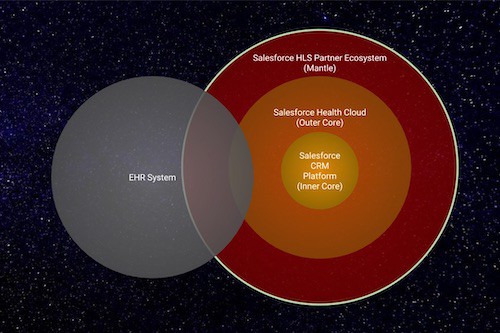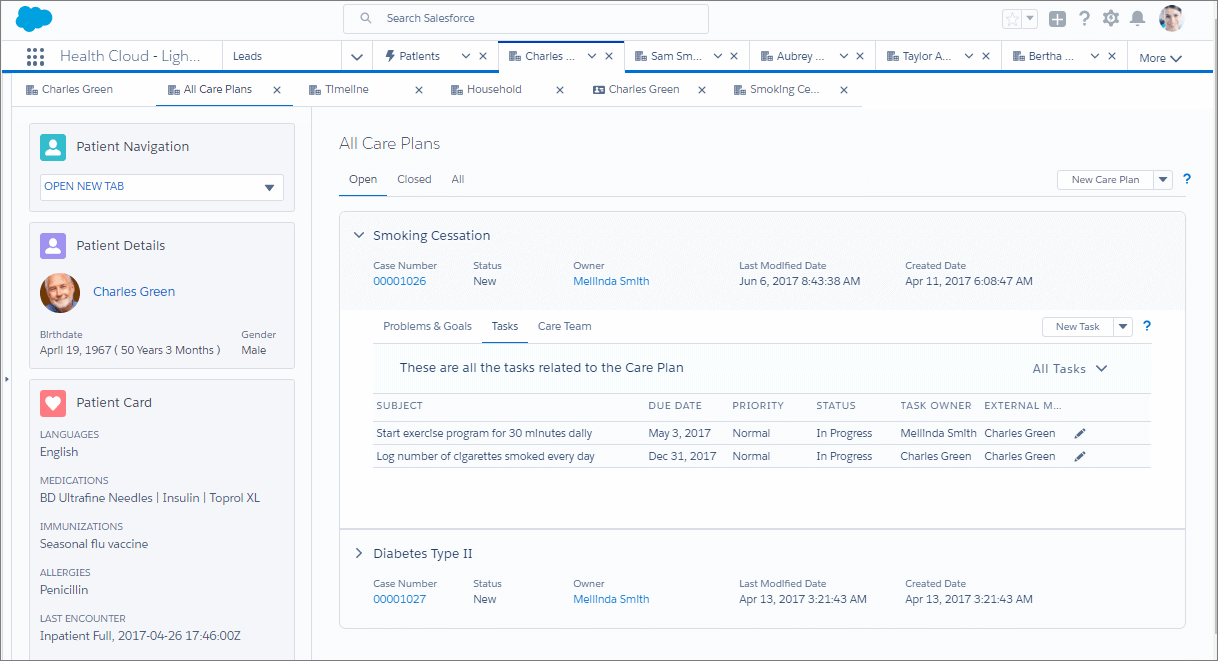We are often asked what the difference is between Salesforce Health Cloud and EHR software.
While there are some areas where these two systems overlap, the underlying purpose for each differs. We’ll explain the differences by contrasting the vendor environment and product offerings for both EHR and Salesforce Health Cloud.

What is EHR Software?
I’ll use “EHR” to reference both EHR and EMR, even though there are differences between those two categories that warrant a separate comparison.
Many of today’s EHR systems are positioned as a combination of practice management, electronic health records, and medical billing. Specific functions include scheduling, patient reminders, and e-prescribing.
One EHR vendor’s tagline is “See Patients. Get Paid.” With this in mind, EHR’s focus can be viewed as maximizing the value of existing patients.
To some extent, EHR is a cousin of the “back office” ERP system, which is a popular application in industry. Well-known ERP vendors include SAP and Oracle.
Among hundreds of EHR software brands are Epic, Cerner, Allscripts, and NextGen Healthcare.
There are other specialized EHR systems such as Welligent for community-based behavioral health or Eyefinity EHR for optometry practices.
In general, EHR vendors do not promote the ability of customers to substantially customize their applications. Nor do they reference an ecosystem of third-party developers and products. EHR systems tend to be purpose-built systems for which the vendors alone are responsible for continuous improvement. This is an important distinction from Salesforce Health Cloud.
What is Salesforce Health Cloud?
Salesforce Health Cloud is a layer of pre-developed functionality for healthcare organizations built on top of the popular Salesforce CRM (customer relationship management software) platform.
Salesforce is in use by over 150,000 organizations and has more than 3.75 million users across many different industries. Salesforce.com’s FY19 revenue was $13.28 billion which was up 26% year-over-year.
One of the reasons that Salesforce has been so successful is that the company’s main offering is a platform for building industry-specific functionality on top of a core foundation.
Salesforce is malleable both as a database and as a user interface. This malleability translates into the ability for internal developers at Salesforce and third-party developers to extend Salesforce in a wide variety of ways in order to create specific healthcare solutions.
We’ll use the analogy of the Earth’s layers to put the overall Salesforce offering for healthcare into perspective.
1. CRM: The Inner Core
At its core, Salesforce excels in helping organizations acquire and retain customers through:
- Lead management
- Customer relationships and data
- Vendor relationships
- Prospect and customer marketing campaigns
- Customer support
- Task management
- One-click logging of 1:1 customer email communication
These core functions of CRM inherently translate into a number of addressable areas in healthcare. Many of them are capabilities that allow for more effectively reaching outside a practice. These include:
- New patient acquisition
- Physician recruitment
- Physician outreach
- Patient marketing campaigns
- Patient complaint logging
- One-click logging of 1:1 patient & physician email communication
2. Salesforce Health Cloud: The Outer Core
Health Cloud layers additional functionality on top of the CRM core. Health Cloud is also part of the combined core, as its functionality was developed internally at Salesforce.
With each of Salesforce’s seasonal releases (Spring, Summer & Winter), more functionality is added to this layer. Here are some examples of current functionality:
- Care plan tracking and management
- Patient risk stratification
- Patient communities
- Patient assessments
- Patient surveys
Learn about J2 Interactive’s Health Cloud services
3. The Healthcare & Life Sciences Partner Ecosystem: The Mantle
The Salesforce partner ecosystem is the third layer. For our analogy, this layer is outside of the core, as it is made up of dozens of third-party software developers and service organizations.
The ecosystem is so large, that it even has a label: The Salesforce Economy.
Third-Party Software Developers
As with other industries, Salesforce encourages the participation of healthcare ISVs (independent software vendors).
One of the third-party software vendor products listed on the Salesforce AppExchange includes RideToHealth.
In another post, we covered two vendors that offer a HIPAA-compliant form builder.
Third-Party Service Organizations
Consulting organizations such as J2 Interactive help healthcare organizations with implementation, integration, and training.
At many practices that use Health Cloud, Salesforce is integrated with the EHR system. An integration might synchronize core EHR patient data with Health Cloud, but not the entire clinical history of patients.
Salesforce pioneered the move of CRM from client/server to cloud-based, starting in 1999. EHR software has been slower to move to the cloud, but the trend toward the cloud will continue. In general, it’s easier to integrate a cloud-based CRM system with a cloud-based EHR system.
With the acquisition of MuleSoft, Salesforce has more native integration capabilities. In many cases, partners like J2 will continue to be involved in the services component of EHR integration.
Is it possible that a Salesforce ecosystem member will build an entire EHR system on the Salesforce platform? Some third-party vendors are already moving in that direction. Plus, I referenced ERP earlier. A company called Accounting Seed built an entire ERP system on the Salesforce platform.
4. The Salesforce User and Patient Experience: The Surface

Just because Salesforce Health Cloud is comprised of these different layers, it doesn’t mean that the system is complicated for end-users.
In the same way, a photo of the Earth’s surface abstracts from the underlying layers of element-rich rock, Salesforce Health Cloud’s user experience abstracts from its rich underlying layers.
In fact, Salesforce’s Lightning Experience interface was designed for easy interaction by developers, administrators, users, and patients. It allows for presenting the right set of screens for each user type at each organization.

While many practices start with an EHR system, Salesforce Health Cloud is often added to complement EHR. Whether the driver for Health Cloud is acquiring new patients or whether it’s taking advantage of specific third-party functionality that can improve patient outcomes, many practices are evaluating and implementing Salesforce Health Cloud.
Salesforce Health Cloud to EHR Integration
J2’s Native FHIR Gateway app establishes bidirectional data sharing between Salesforce Health Cloud and any EHR that supports the FHIR standard—or any integration platform that can broker FHIR transactions on behalf of systems that don’t support FHIR natively.



